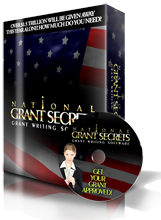How to Write a Grant Application
Some grant proposal guidelines follow boiler plate formats and use pre-generated forms which make completing the grant application somewhat easier in that it becomes an exercise (sort of) of filling in the blanks.
As mentioned previously, almost every grant making body incorporates its own criteria into the grant proposal application. The sheer variety of formats can be mind boggling but once you understand the general guidelines within which most funding agencies base their review processes on, you realize that there are only a few dimensions to which most grant proposals conform.
Some grant proposal guidelines follow boiler plate formats and use pre-generated forms which make completing the grant application somewhat easier in that it becomes an exercise (sort of) of filling in the blanks.
However, the following sub-divisions form the nexus of most grant proposal headings and subjects:
- Summary or an Executive Summary: the proposal should begin with a brief summary or executive summary of the project or program and should be included on the cover sheet or at the beginning of the proposal. It should state clearly the name of institution or organization, what the project is and how much is being requested
- Organization or Institution Information: this is the section where you introduce your organization, its corporate structure; i.e. non profit, etc…, what its primary activities are, its mission, what community or population is served or will benefit, and the historical achievement of the entity. Inform the grant making body of your organization’s budget, who owns/manages the organization, industry affiliations, and briefly make the case why your organization can be trusted to appropriately manage and utilize the grant award that is being requested
- Problem/Program/Project Description: this is the section where you describe in detail the program or project that is the target of the funding request. Be descriptive but be concise. This is not the place to be Earnest Hemingway but make it interesting and clearly indicate how the project or program aligns with the stated mission and objectives of the awarding agency.
Also, do not assume that the awarding agency staff, reviewers and board have the same level of expertise and familiarity with your project or program as you do
- Project Plan/Timeline: outline the project/program goals and the objectives supporting those goals. Include a mockup graphic of the project outline or timeline with approximate kill dates, deadlines, and milestones. This will inform the reviewers that you and your organization are prepared to complete the project or program successfully at the outset rather than waiting for funding to just start the planning phase.
- The Outcome & Impact Analysis: inform the funding agency what the final result is expected to be of the project. For example, in a research related project the outcome will be the conclusion of the research; i.e. was the hypothesis confirmed of disproved.
- Other Funding Sources: this details whether your project is depending on multiple grant awards and additional sources of funding in order to be completed. The funding organization can gain a better perspective on the success of your project or program based on the percentage of funding need its award is expected to fulfill
- Future or Ongoing Funding: since most funding agencies are not interested in adopting an ongoing funding need they are interested in reviewing program expectations regarding future funding needs. This informs the funding agency how you have planned for the long-term sustainability of a project or program
- Evaluation Metrics: this section informs the funding agency how you intend to determine actual project success. Simply spending the money on the stated activities does not actually ensure that the project or program proved successful relative to its objectives
- Project/Program Budget: this is one of the most important sections of the grant proposal because it relates to specific uses of the funds being requested in the proposal. In general, the budget should consist of the following section:
1) personnel expense
2) direct project/program expenses
3) administrative/overhead expenses.Additionally, the budget should account for expected revenues as well including the grant funding being sought
- Appendix/Supplementary Documentation: this section can include a wide variety of material depending on the type of grant, the funding agency’s requirements, as well as your own organization type and structure. However, typically most grant proposals should include the following documentation:
1) IRS corporate classification or IRS declaration of tax exempt status,
2) list of the board of directors and professional affiliations,
3) complete financial statements for the last fiscal period,
4) a current budget,
5) an project or pro forma budget for the following year, and
6) resumes or CVs of responsible individuals related to the project or program
Grant Proposal Secrets Mini-Course Here
Get immediate access to our email mini-course, "Grant Proposal Secrets," and gain rare insight into winning more grants. Simply enter your name and email address below to get access
You'll get the first lesson in your inbox immediately:



**Double-check your email for accuracy to ensure you receive your free mini course.
Privacy Assured:
Your email address is never
shared with anyone
Grant Proposal Secrets Mini-Course Here
Get immediate access to our email mini-course, "Grant Proposal Secrets," and gain rare insight into winning more grants. Simply enter your name and email address below to get access

You'll get the first lesson in your inbox immediately:



**Double-check your email for accuracy to ensure you receive your free mini course.
Privacy Assured:
Your email address is never
shared with anyone

